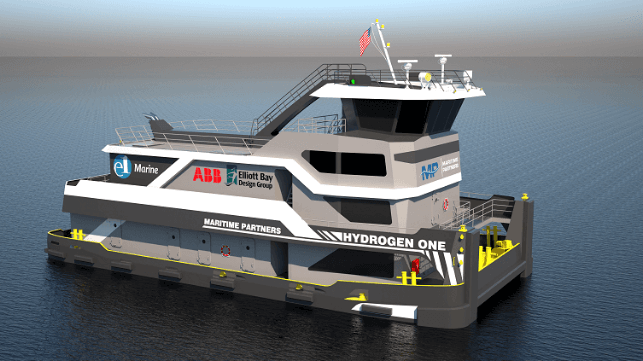USCG Agreement Sets Development Pathway for First Hydrogen-Power US Towboat

The project that has been underway for the past several years to develop the U.S.’s first hydrogen-power towboat reached a critical agreement with the U.S. Coast Guard that provides a pathway forward. Maritime Partners, which is leading the project, signed a Design Basis Agreement with the USCG for the Hydrogen One towboat that will use a novel technology that produces hydrogen aboard the ship eliminating the challenges of bunkering and storing hydrogen.
“The signing of this agreement opens the pathway for us to deploy our technological capabilities,” said Bick Brooks, co-founder and CEO of Maritime Partners. “With this, Hydrogen One is one step closer to becoming the world’s first vessel to utilize hydrogen generator technology greatly reducing emissions, increasing efficiency, and providing a model for cleaner energy use as the industry continues to seek ways to decarbonize.”
The DBA process was established by the U.S. Coast Guard to set the rules for new and novel technology proposed for installation on marine vessels. By reaching the agreement, they explained that the project would be working towards an agreed-upon framework with the U.S. Coast Guard for the design, arrangement, and engineering aspects of the power system and associated safety systems. It established a plan for the review, inspection, and eventual certification of the Hydrogen One.
The towboat is being designed as a first-of-its-kind vessel using new, cleaner, fuel cell technology that works by converting stored methanol to hydrogen. The produced hydrogen is output, on-demand, to the fuel cell to generate power for the vessel.
When the project was revealed in 2021, they said the towboat would be nearly 89 feet (27 meters) and designed to push barges from the Port of New Orleans along the Mississippi River and its tributaries. They projected the vessel will be able to travel for up to about four days at a speed of 6 knots, or cover a total of 550 miles, with a load between fueling. The concept called for a propulsion system capable of generating up to 2,700 HP propulsion power, with 1,700 HP generated by the fuel cell and the remainder from batteries.
The partners report that a string of successful tests of the technology were completed in Sweden in 2023. They said it demonstrated the viability of the technology as the sole power generation source for the vessel’s propulsion.
Maritime Partners worked with several industry leaders on the Hydrogen One project, including Seattle-based Elliott Bay Design Group, which is designing the towboat, and Intracoastal Iron Works which was selected as the shipyard to build the vessel. e1 Marine, which holds the license for the technology also worked with RIX Industries, Power Cell Group, among others, to work through the U.S. Coast Guard requirements. ABB Marine & Ports reported in 2021 that it would also participate in the project providing the electrical propulsion plant, including motors, transformers, and the integration of the fuel cell system.
Only a handful of hydrogen-powered vessels have entered service, mostly in Europe. In the U.S. the Sea Change ferry went through a long development process which experienced delays after the hull was launched in 2021 before it finally arrived in San Francisco in 2023. By entering the DBA process, the goal is to ensure a smooth process to move the Hydrogen One through design and into operation.
